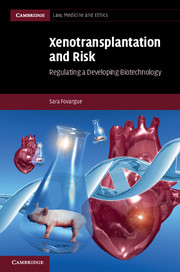Book contents
- Frontmatter
- Contents
- Acknowledgements
- 1 Introducing the issues
- 2 Dealing with risk
- 3 Regulating experimental procedures and medical research
- 4 Regulatory responses to developing biotechnologies
- 5 Challenges to legal and ethical norms: first-party consent and third parties at risk
- 6 Surveillance and monitoring: balancing public health and individual freedom
- 7 Summary and concluding thoughts: looking to the future
- Bibliography
- Index
7 - Summary and concluding thoughts: looking to the future
Published online by Cambridge University Press: 05 December 2011
- Frontmatter
- Contents
- Acknowledgements
- 1 Introducing the issues
- 2 Dealing with risk
- 3 Regulating experimental procedures and medical research
- 4 Regulatory responses to developing biotechnologies
- 5 Challenges to legal and ethical norms: first-party consent and third parties at risk
- 6 Surveillance and monitoring: balancing public health and individual freedom
- 7 Summary and concluding thoughts: looking to the future
- Bibliography
- Index
Summary
Advancements in biotechnology have the potential to alter not just our environment but our physical embodiment as well. In altering not merely our social, cultural, economic or political environments, but the physical foundations of life itself, the decision to adopt a particular biotechnology may be irrevocable and the results irreversible. There can be no turning back from a decision to alter our biological destiny.
It is indisputable that there is a significant and costly disparity between the number of patients who require an organ transplant and the number of organs currently available for transplantation. The desire to support or promote xenotransplantation as part of the solution to this shortage is understandable but the implications of doing so must be acknowledged and addressed because ‘[a]dvances which may seem to be the answer to a pressing problem may well entail consequences of such a drastic nature as to cause researchers to halt and take stock of their situations before proceeding further’. The science behind xenotransplantation continues to develop and although some of the initial barriers to placing a non-human animal organ into a human appear to have been addressed, it remains unclear whether a solid organ xenotransplant will be able to support a human life. In addition, performing such a transplant may transfer infectious diseases across the species boundary to the xeno-recipient and others, and it is this risk which requires global legal and regulatory attention. While porcine endogenous retroviruses have been the main focus to date, it is anticipated that other organisms will need investigating and that latent diseases may be transmitted to the xeno-recipient and others. These risks and their unknown nature and magnitude make xenotransplantation a useful case study through which to explore the role of science in society, public involvement in science and decision-making, risk, responsibility (individual, societal, governmental), regulation, public health and the global ‘market’. These themes have underpinned the discussions within this book, along with the idea that developing biotechnologies may pose challenges to established legal and ethical norms.
In Chapter 2, I explored the risks posed by genetically engineered solid organ xenotransplants and argued that in situations of uncertainty a precautionary approach informed by the harm principle is an appropriate response because where the risk is significant with regard to the probability of transmission and the severity of harm, action should be taken to prevent harm to public health. This approach is required because ‘[t]oo often . . . public health and environmental policies are based on a principle of reaction rather than precaution’ with regulatory agencies ‘having to wait until evidence of harm is established beyond all reasonable doubt before they can act to prevent harm’. Adopting a precautionary approach does not necessarily mean that such xenotransplants cannot be performed, but it does require society to consider whether it is appropriate to proceed to clinical use when possible individual benefit may place public health at risk. Xenotransplantation is thus a useful reminder that health care involves protecting and enhancing the health of individuals and that of the public, and that ‘a shift from reaction to precaution is entirely consistent with the core values of public health practice’. The UK government has acknowledged the importance of public health and commented that:
[m]odern biotechnology is an important area of scientific advance which offers enormous opportunity for improving our quality of life. But there is also understandable public concern about a technology which allows scientific advances which we would have hardly imagined possible only a few years ago. The Government's overriding responsibilities are to protect the health of the public and to protect the environment.
- Type
- Chapter
- Information
- Xenotransplantation and RiskRegulating a Developing Biotechnology, pp. 237 - 246Publisher: Cambridge University PressPrint publication year: 2011



